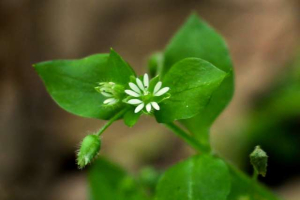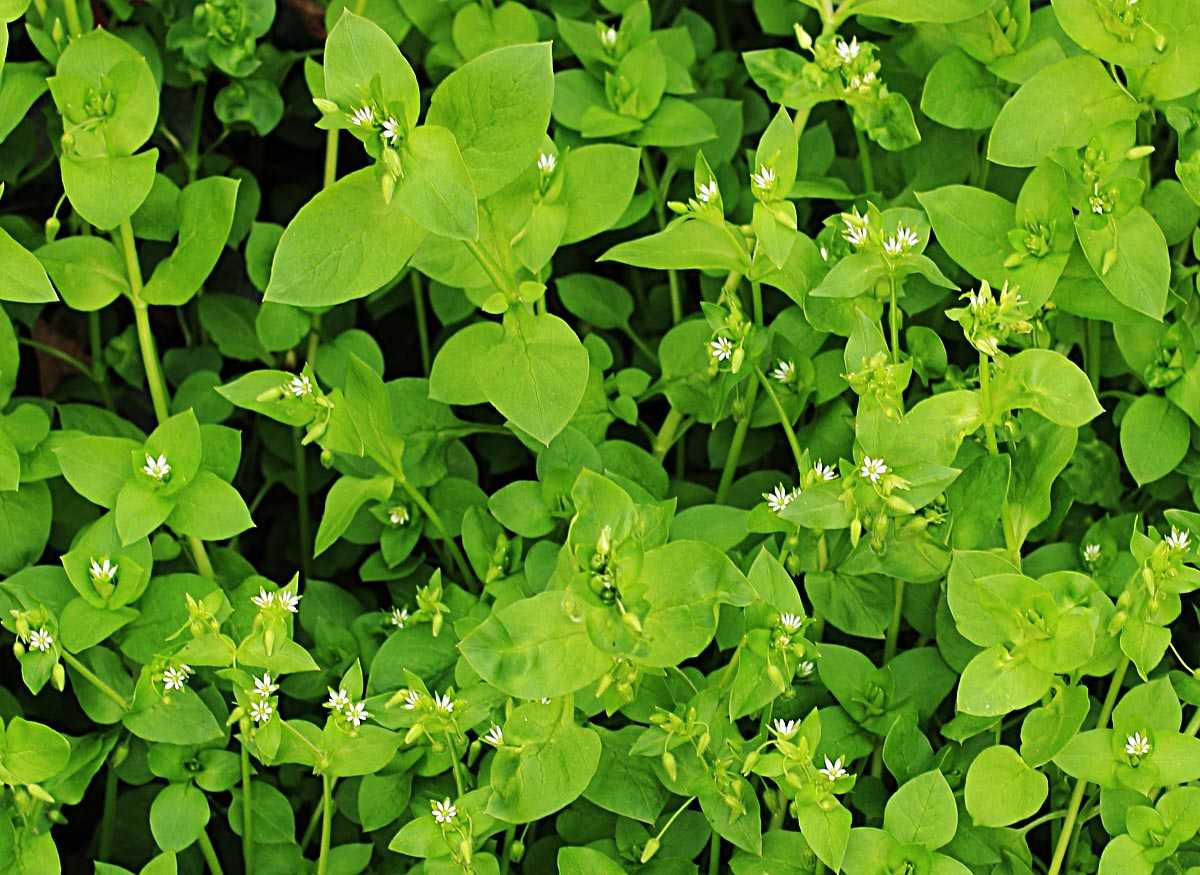The name "chickweed" most notably describes Common Chickweed (Stellaria media), although there are several other chickweeds, all in the genus Stellaria.
Common Chickweed is a cool weather plant native to Europe that has widely naturalized in the United States and throughout the world.
It’s often found in lawns and other areas of sun to partial shade in moist soil.
In a temperate climate like our southern Appalachians, chickweed normally appears during the cooler temperatures of fall and dies back in the late spring or early summer heat, but it’s typically considered an early spring plant.
It thrives between 53° and 68°F.

Chickweed flower
Identification
The stringy but succulent stems of chickweed can grow up to a foot and a half or so and produce tiny white flowers throughout the growing season.
Its pointed oval-shaped leaves grow in pairs opposite each other, fairly far apart on the stem. Leaves can be anywhere from 1/4 to 1 1/4 inch long.
Chickweed flowers are 1/8 to 1/4 inch in diameter and consist of five double-lobed white petals supported by a whorl of five green sepals.
The flowers somewhat resemble carnation flowers -- chickweed is actually a member of the carnation family, Caryophyllaceae.
It has a few lookalikes but a few distinguishing factors are:
1) Chickweed does not have milky sap. Try pulling the stem apart. If there’s no milky sap, you’re more likely to have chickweed.
2) It has a line of “hair” along the stem, which alternates between the joints.
3) The inner stem of chickweed is elastic, so if you gently pull the stem apart, the outer sheath will separate while the inner part will stretch.

Nutritional value
According to this open-source food study of wild greens, chickweed is rich in Vitamins A and C, as well as calcium, fiber and and number of other minerals.
It's also interesting that serving sizes are listed as one cup for both kale and chickweed. While a cup of kale weighed 21 grams, a cup of chickweed weighed nearly five times as much at 101 grams, so chickweed is much more dense.
Habitat and harvesting
Chickweed is a common yard weed--it’s considered a pest by some so be sure not to gather it in areas that have been sprayed with pesticide.
To harvest, simply cut the stems with scissors--cut either the tops or the base depending on how much you need and how much is available.
For larger, leggy plants, you may want to use only the leaves. Be sure to remove any yellow or brown leaves.
Preparing and eating
Chickweed is a not only a super plant in terms of its nutritional acclaim, but it’s also delicious.
The flavor is often compared with corn silk. It’s pleasant and mild.
Chickweed is excellent raw -- use it like sprouts; eat it in sandwiches, wraps, etc. And of course it’s a great base for salad.
It’s also great steamed or sauteed and makes a good substitute for spinach.
Chickweed doesn’t do well refrigerated which probably explains the fact that it never made it as a commercial crop, even though it was a popular edible garden plant in the 1800s.
It’s best eaten fresh so plan to use it within a day or so of cutting. Eat the stems, leaves, flowers, and seed pods.
Since chickweed is so prolific, it’s really easy to get enough for a meal or 10 in a short time.
See Steve Brill's tips for preparing chickweed: